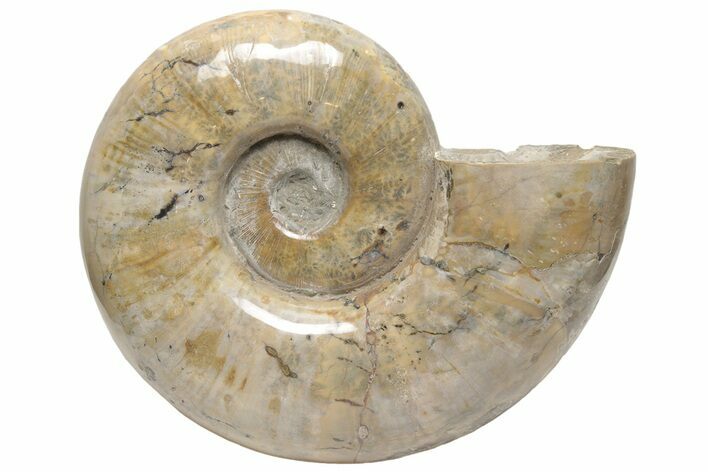This Specimen has been sold.
14.6" Polished Ammonite (Argonauticeras) Fossil - Madagascar
This is a huge, 14.6" wide polished ammonite fossil (Argonauticeras besairiei), collected near Ambatolafia, Madagascar. It makes for a very impressive display on the included metal display stand.
You rarely get ammonites of this size and condition of out Madagascar. While it does have repair work, this is to be expected on large ammonites that will be found already fractured in the ground. There is a small amount of purple iridescent flash on some areas of the specimen. All of the rock has been carefully removed from the chamber on the very end of the ammonite adding to its appeal.
You rarely get ammonites of this size and condition of out Madagascar. While it does have repair work, this is to be expected on large ammonites that will be found already fractured in the ground. There is a small amount of purple iridescent flash on some areas of the specimen. All of the rock has been carefully removed from the chamber on the very end of the ammonite adding to its appeal.
About Ammonites
Ammonites were ancient marine cephalopods, similar to today's squids and octopuses, but with a defining feature: their distinctive, tightly coiled spiral shells. These shells, resembling those of modern nautiluses, served as both a protective home and a buoyancy aid, allowing ammonites to navigate the prehistoric seas with ease. First emerging around 240 million years ago in the Triassic Period, ammonites thrived for over 175 million years, adapting through numerous forms and sizes. As predatory creatures, they likely fed on smaller marine organisms, using their tentacles to capture prey. However, their long reign came to an end 65 million years ago at the close of the Cretaceous, coinciding with the mass extinction event that also eliminated the dinosaurs.
Ammonites were ancient marine cephalopods, similar to today's squids and octopuses, but with a defining feature: their distinctive, tightly coiled spiral shells. These shells, resembling those of modern nautiluses, served as both a protective home and a buoyancy aid, allowing ammonites to navigate the prehistoric seas with ease. First emerging around 240 million years ago in the Triassic Period, ammonites thrived for over 175 million years, adapting through numerous forms and sizes. As predatory creatures, they likely fed on smaller marine organisms, using their tentacles to capture prey. However, their long reign came to an end 65 million years ago at the close of the Cretaceous, coinciding with the mass extinction event that also eliminated the dinosaurs.
SPECIES
Argonauticeras besairiei
LOCATION
Ambatolafia, Mahajanga Province, Madagascar
SIZE
14.6" wide,5. 6" thick, 39 lbs
CATEGORY
SUB CATEGORY
ITEM
#210389
We guarantee the authenticity of all of our specimens.
 Reviews
Reviews













